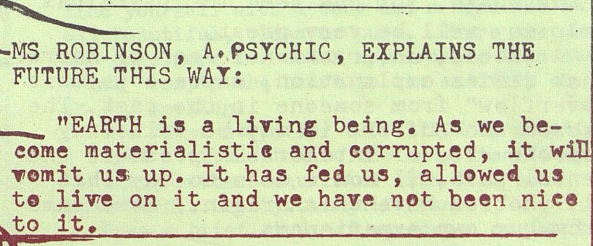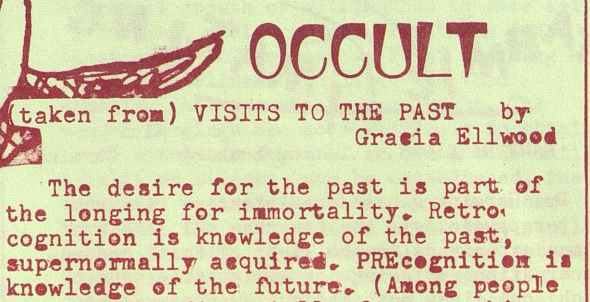Susan Rennie and Kirsten Grimstad co-edited The New Woman’s Survival Catalog in 1973. Some of its contents were republished by Rennie and Anna Rubin in the first issue of Chrysalis, published out of the Los Angeles Woman’s Building from 1977-1981.
Information for the catalog was originally collected by the authors during a multi-month road trip, which included tracing the “underground survival” of women’s wisdom such as homeopathy, herbology, and forms of psychic healing. In Chrysalis, Rennie and Rubin acknowledged “two sides” of herbology: the medicinal and the magical. “Herbalist lore” surrounding love potions, they argued, accounted for some of the dismissal of women’s herbal wisdom and its medicinal uses within the mechanized healthcare systems of the United States.
Susan Rennie wrote A Feminist Tarot with Sally Gearhart, published in 1976 by the lesbian feminist Persephone Press in Watertown, Massachusetts.
Womanspirit was published quarterly between 1974 and 1984 near Wolf Creek, Oregon. It was the first lesbian feminist publication devoted to both feminism and Spirituality. From its inaugural issue:
Ruth & Jean Mountaingrove (Womanspirit founders), Womanspirit, Vol. 1, Iss. 1, Autumn Equinox, 1974
Pastor Brenda L. Haywood, “Nubian Woman,” etching on English scratch-board, Conditions 5: The Black Women's Issue, Vol. 2, Iss. 2, Autumn 1979
Co-edited by Barbara Smith and Lorraine Bethel, Conditions 5: The Black Women’s Issue challenged Black women’s invisibility within feminist press networks. Pastor Brenda L. Haywood’s cover art “The Nubian Woman” served as a window into themes of self-worth and reclamation outside of white structures of power, emergent in Black women’s spirituality and explored in Audre Lorde’s The Black Unicorn reviewed later in the issue (see below).
Haywood is the founder of Racial Justice Provincetown and formerly served as reverend of the Unitarian Universalist Meeting House of Provincetown. “It’s important for me to keep going,” Haywood told The Provincetown Independent after receiving the Tim McCarthy Human Rights Champion Award in 2019. “It’s a way of thanking my mentors who were here for me, individuals who inspired me. I give, and in turn, I receive.”
Assorted Classified Advertisements for Women’s Spirituality, Pointblank Times, 1976 - 1978.
Fahamisha Shariat Brown, “Review: Audre Lorde’s The Black Unicorn,” Conditions 5: The Black Women's Issue, Vol. 2, Iss. 2, Autumn 1979
Fahamisha Shariat Brown read in poetry circles alongside Audre Lorde and Adrienne Rich, and was a member of the Black Arts Movement of the 1960s and ‘70s. A teacher, lecturer, and performing artist, she wrote Performing The Word: African American Poetry as Vernacular Culture under the name Fahamisha Patricia Brown in 1999.
In The Black Unicorn (1978), Audre Lorde established a reclamation of Black women’s spiritual authority through poetry, woven together by references to African Mythology. Lorde situates African Goddess symbolism and forms of ancient magic in contrast to the racist, sexist, and homophobic realities of contemporary American society. In rejecting patriarchal mythology and centering the pre-patriarchal African Goddess, Lorde imagines a unique Spirituality outside of a Judeo-Christian worldview that draws upon ancient strength in combating systems of oppression.
Unknown Artist and Cheri Lesh (aka Cerridwen Fallingstar), “Holydays Of The Goddess,” Lesbian Tide, March/April 1978
As the Women’s and Gay Liberation Movements progressed, goddess imagery became increasingly popular. The Goddess Spirituality Movement drew practitioners who sought to utilize goddess symbolism as a tool for both spiritual and social liberation. The movement grew out of contemporary forms of Paganism of the sixties and seventies, initially drawing feminists who felt oppressed or rejected from their inherited religious practices. Goddess Spirituality used feminine language and spoke to the dynamic attributes that its practitioners sought to project: warrior-like, nurturing, wrathful, and divine. Sixties-era feminism proclaimed that the “personal was political,” and for women who ritualized the Goddess, the personal was political as well as spiritual.
In “Holydays Of The Goddess,” Cheri Lesh (now known as Cerridwen Fallingstar) described historical meanings of rituals to Pagan practitioners, and the symbolism behind festivals associated with various Goddesses in mythology.
Under the “Events” page later in the same issue, The Lesbian Tide advertised “THE GREAT GODDESS RE-EMERGING CONFERENCE” taking place at UC Santa Cruz—its purpose to “explore the story and wisdom of the Goddess.”
Fallingstar is the author of the Witchcraft novel, The Heart of the Fire; the White as Bone, Red as Blood series set in 12th century Japan; and her memoir Broth from the Cauldron: A Wisdom Journey through Everyday Magic (2020).
Gloria Anzaldúa, El Mundo Zurdo, part six of This Bridge Called My Back: Writings of Radical Women of Color, 1981
















